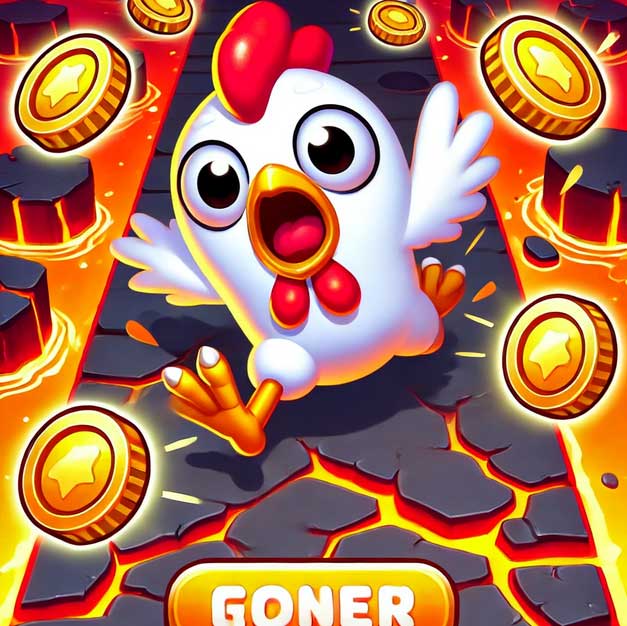Chicken Road Game – a crash-style arcade that grabs your attention fast
Chicken Road Game is not your typical mobile arcade. It falls into the category of crash games — fast, dynamic, and built around sharp reflexes and sudden outcomes. From the moment the round begins, the player is thrown into a test of timing and risk. It’s all about knowing when to move and when to wait, because one wrong step ends it all in an instant.
What makes this game especially gripping is how quickly it builds tension. You’re constantly balancing progress with danger, step by step. Each move feels like a gamble — and that’s exactly what keeps players locked in. The stakes are simple but high, and the more you play, the more tempting it becomes to push just a little further.
The game doesn’t rely on drawn-out storylines or complicated systems. Its power lies in its immediacy. One button, one decision, one consequence — and just like that, it’s over or you’re still going. This kind of design appeals to both quick-session players and those chasing long-term improvement.
Chicken Road Game knows exactly what it is: fast, punishing, and surprisingly fun. Whether you’re aiming for a new personal best or just want a short thrill, it delivers that high-stakes arcade feel from the first tap.
How this arcade stands out from similar games in its genre
With so many crash and reflex-based games available today, it’s easy for titles to blend together. However, this one manages to rise above the crowd by focusing on execution over excess. There’s no cluttered interface, no endless menus — just quick action, clean visuals, and instant engagement. That focus on core mechanics is what separates it from more bloated competitors.
Where many games try to hook players with flashy effects or complex upgrade systems, here the hook is the experience itself. Each session is short, sharp, and satisfying — the kind of play that encourages improvement without artificial rewards. You’re not grinding for points to unlock cosmetics; you’re sharpening your timing and instincts, which creates a much stronger long-term loop.
Another distinction lies in the way the difficulty scales. Instead of overwhelming players with chaos, the challenge increases subtly, giving you time to adapt while still pushing your limits. That makes the game feel fair but firm, something that’s rare in this genre.
For those curious to discover other similarly engaging, minimalistic titles, resources like https://offtheshelf.in/ are great for finding experiences that prioritize gameplay over gimmicks.
While comparisons to classics like Crossy Road are inevitable, this arcade holds its own by leaning into simplicity, rewarding awareness, and providing fast feedback that keeps players invested. It’s not about reinventing the genre — it’s about doing the essentials better.
How Chicken Road Game was created: inspiration, concept, and release
Every crash-style game starts with a core idea: tension, risk, and a quick outcome. In this case, the creators wanted to take that energy and channel it into something both playful and sharp. The concept began with a simple question — what if crossing the road wasn’t just a casual task, but a challenge that demanded absolute timing? From there, the project took shape.
The development process focused on delivering that instant thrill. Instead of building layers of complexity, the team concentrated on creating a game where every move counted. Early versions tested player reactions, obstacle pacing, and visual clarity, all while keeping the structure lean and addictive. The result was a formula that emphasized speed, risk, and repeat play.
Inspiration came not only from classic arcades but also from the newer generation of crash titles where the goal isn’t just to win — it’s to outlast your last run. That idea of pushing slightly further each time, with a single misstep ending everything, became the game’s core.
Once released, the feedback was immediate. Players appreciated the no-frills intensity and the way the game demanded focus without overcomplicating the experience. It wasn’t just about dodging traffic — it was about learning, reacting, and improving with each attempt. That’s what helped the game stand out from other fast-action titles.
What makes the gameplay so tense and hard to quit
The tension in this crash-style arcade hits immediately — no warm-up, no second chances. One mistake ends the run, and that constant pressure is exactly what fuels the excitement. Each move forward carries a weight, and the further you go, the more you feel the risk rising. It’s not about just surviving, it’s about knowing how far you can push without slipping.
The core mechanic is built on timing. You’re forced to read traffic, wait for openings, and commit at the perfect moment. It’s a rhythm of hesitation and burst action. That balance — between waiting too long and jumping too soon — creates an addictive loop where players are always trying to outsmart the game.
This type of gameplay doesn’t rely on complex levels or changing rules. It’s repetition with variation. Every round feels familiar, but never the same. Small differences in obstacle speed or placement make each session unpredictable, keeping the player alert and reactive.
Over time, patterns begin to emerge, and so does strategy. The more you play, the more you internalize the movement logic, turning reflex into instinct. That growth is what makes the gameplay feel rewarding — it’s not just a test of speed, but of control under pressure.
How the visual and audio design boost player focus and tension
The visual style in this crash arcade is intentionally clean, with sharp contrasts and clear shapes that help players read the environment in a split second. Nothing clutters the screen or distracts from the main objective — every visual element has a purpose. Movements are fluid, and animations are crisp, giving the game a polished feel without overcomplication.
Sound design works alongside the visuals to increase immersion. Subtle effects highlight every move — the tap of each step, the whoosh of passing danger, the abrupt silence of failure. There’s no need for a complex soundtrack; instead, the audio is focused, dynamic, and tied directly to the player’s actions. This makes each run feel more immediate, more alive.
Together, the visual and audio feedback form a loop of constant communication. You don’t just see what’s happening — you feel it. Quick reactions become more natural because the cues are so tightly woven into the rhythm of the game. Whether you’re advancing cautiously or darting through chaos, the interface supports your decisions without drawing attention to itself.
This minimal but deliberate presentation style reinforces the crash-game identity — fast, risky, unforgiving. It doesn’t aim to be beautiful in a traditional sense, but functional, responsive, and highly effective at keeping you locked in.
How to get better at Chicken Road Game and avoid common mistakes
Improvement in any crash-style arcade isn’t about luck — it’s about rhythm, observation, and decision-making under pressure. This game rewards players who learn from failure, adapt quickly, and develop a natural sense of timing. You don’t need to master complex strategies, but consistent habits make all the difference between a short run and a high score.
One of the most common errors new players make is rushing. In this type of gameplay, speed without awareness leads to instant failure. The key is to learn pacing — knowing when to pause, when to advance, and how to read the flow of movement around you. Patience can often be the difference between surviving another step or restarting entirely.
Another issue is tunnel vision. Focusing only on the next tile or lane can blind you to approaching hazards. The more effective approach is to scan the space ahead and make decisions two or three moves in advance.
Here’s a comparison between common habits and better alternatives:
| Common Mistake | Better Alternative | Why It Matters |
| Rushing into traffic | Waiting for open gaps | Reduces risk and increases decision accuracy |
| Only watching one lane | Scanning multiple paths | Helps anticipate movement patterns |
| Panicking after mistakes | Resetting focus after each step | Keeps control and rhythm under pressure |
| Playing on full volume | Using sound cues for movement timing | Improves reaction based on subtle audio hints |
| Ignoring early obstacles | Treating every step as equal threat | Maintains consistency and lowers mistake rate |
By gradually replacing reactive habits with smarter ones, players gain more control over the flow of the session. Chicken Road Game rewards steady progress and mental discipline — not just fast fingers. The more you play with awareness, the more each run becomes a lesson that moves you closer to mastery.
Why Chicken Road Game is more than just a quick crash arcade
At first glance, this game might seem like a simple time-killer — a few taps, a few crashes, and you move on. But with every run, it quietly proves there’s more under the surface. It’s a rare example of an arcade that thrives on repetition without becoming repetitive. Its strength lies not in endless content, but in perfecting a single idea: how far can you go without slipping?
The minimal design, combined with high-risk gameplay, creates an experience that sticks. Whether you’re chasing personal bests or just enjoying short bursts of tension-filled fun, it delivers exactly what it promises — without distraction, without filler. Every second counts, and every mistake teaches something.
Chicken Road Game doesn’t rely on flashy hooks or artificial progression. It respects the player’s time, challenges their instincts, and offers that satisfying loop of “just one more try” — the mark of an arcade that truly understands its audience.

